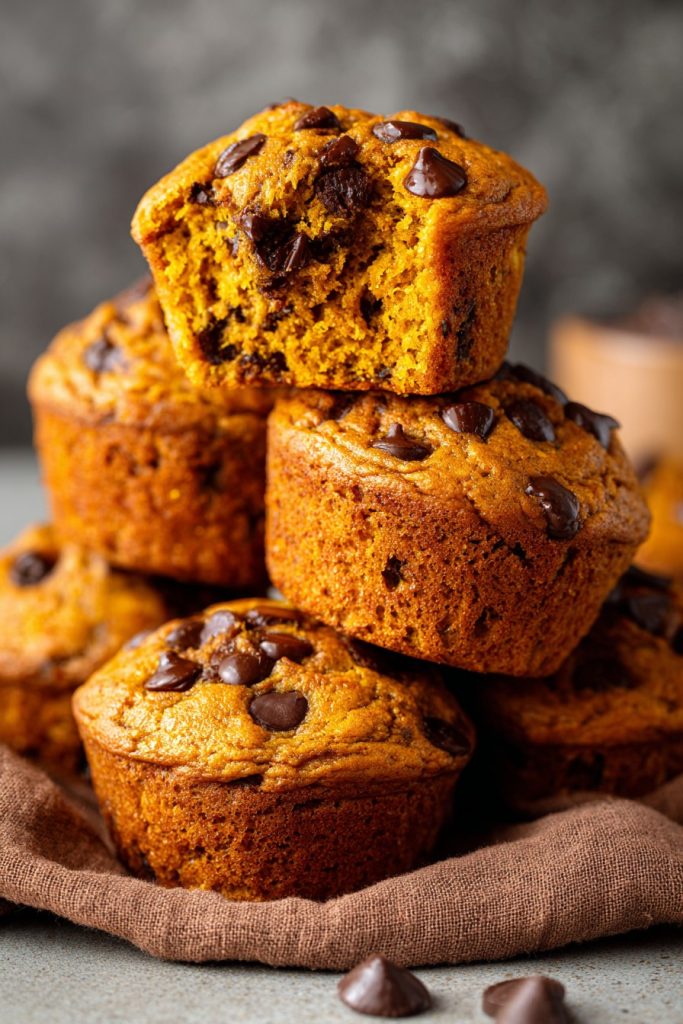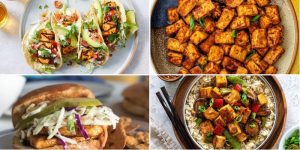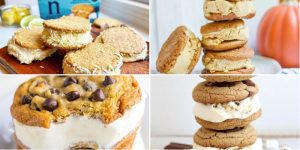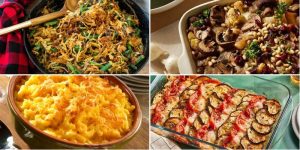Unmistakably autumnal and effortlessly delicious, these pumpkin chocolate chip muffins combine seasonal flavors with simple preparation. Using basic pantry staples and straightforward techniques, this recipe delivers moist, tender muffins with perfect spice balance and melty chocolate pockets. You’ll appreciate how quickly these come together for breakfast, snacks, or dessert.
Why This Recipe Works
- The combination of pumpkin puree and buttermilk creates exceptionally moist muffins that stay fresh for days, preventing the dryness that often plagues pumpkin baked goods while providing the perfect texture foundation for chocolate chips.
- Using both baking powder and baking soda ensures proper lift and an ideal crumb structure, with the baking soda specifically helping neutralize the acidity of the pumpkin and buttermilk while promoting browning.
- The spice blend of cinnamon, ginger, and nutmeg complements the pumpkin flavor without overwhelming it, creating a balanced background that allows the chocolate chips to shine as the primary flavor accent.
- Mixing the wet and dry ingredients separately before combining prevents overmixing, which would develop gluten and create tough muffins, while the resting period before baking allows the batter to hydrate properly.
- The high oven temperature initial bake followed by reduced heat creates the perfect dome and tender interior, with the chocolate chips distributed evenly throughout rather than sinking to the bottom.
Ingredients
- 2 cups all-purpose flour
- 1 ½ teaspoons baking powder
- ½ teaspoon baking soda
- 1 teaspoon ground cinnamon
- ½ teaspoon ground ginger
- ¼ teaspoon ground nutmeg
- ½ teaspoon salt
- 1 cup pumpkin puree
- ½ cup granulated sugar
- ½ cup light brown sugar, packed
- 2 large eggs, room temperature
- ½ cup vegetable oil
- ¼ cup buttermilk
- 1 teaspoon vanilla extract
- 1 ½ cups semi-sweet chocolate chips
Equipment Needed
- Standard 12-cup muffin tin
- Muffin liners or cooking spray
- Large mixing bowl
- Medium mixing bowl
- Whisk
- Spatula
- Measuring cups and spoons
- Cooling rack
- Ice cream scoop or ¼ cup measure
Instructions
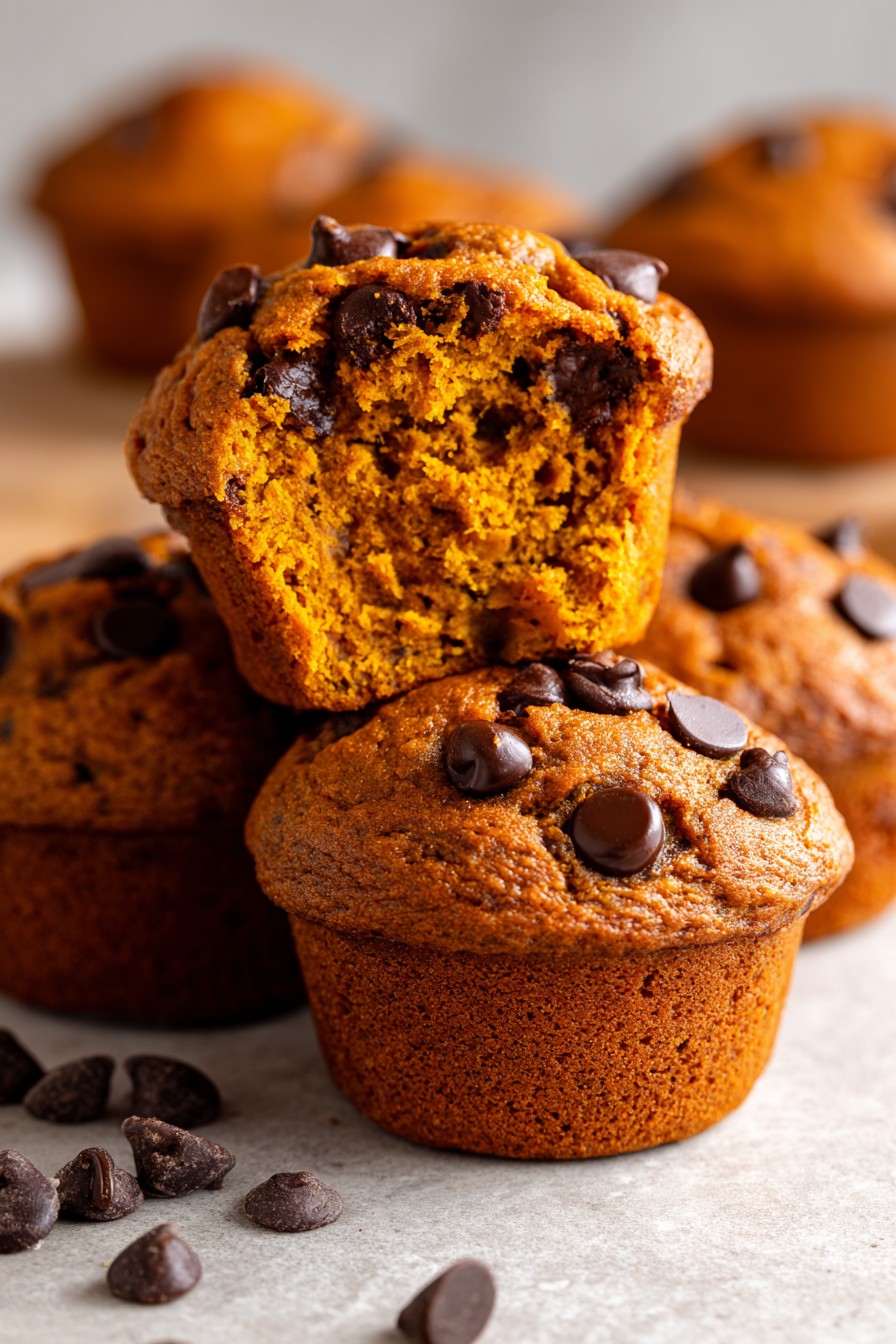
Prepare Dry Ingredients and Oven
Preheat your oven to 425°F and line a 12-cup muffin tin with paper liners or grease thoroughly with cooking spray. In a large mixing bowl, whisk together 2 cups all-purpose flour, 1 ½ teaspoons baking powder, ½ teaspoon baking soda, 1 teaspoon ground cinnamon, ½ teaspoon ground ginger, ¼ teaspoon ground nutmeg, and ½ teaspoon salt until evenly combined and no streaks remain. Take 1 tablespoon of this flour mixture and toss it with 1 ½ cups semi-sweet chocolate chips in a small separate bowl, coating the chips lightly to prevent sinking during baking. This coating technique creates a barrier that helps suspend the chocolate chips throughout the batter rather than allowing them to settle at the bottom of the muffins during the baking process.
Combine Wet Ingredients
Mix Batter and Add Chocolate
Pour the wet pumpkin mixture into the dry flour mixture and use a spatula to fold them together gently until just combined, with no dry flour pockets remaining but small streaks still visible. Avoid overmixing, which would develop gluten and create tough muffins. Add the flour-coated chocolate chips to the batter and fold them in with 3-4 additional strokes until evenly distributed. The batter will be thick but scoopable, similar to a dense cake batter consistency. If the batter appears too thick, you can add 1 additional tablespoon of buttermilk, but avoid making it too thin as this could cause the muffins to spread rather than dome properly during baking.
Fill Muffin Cups and Rest
Using a ¼ cup measure or ice cream scoop, divide the batter evenly among the 12 prepared muffin cups, filling each about ¾ full. The cups should contain approximately the same amount of batter to ensure even baking. Let the filled muffin tin rest on the counter for 15-20 minutes before baking. This resting period allows the baking powder to begin activating and the flour to fully hydrate, resulting in better texture and more consistent rise. During this time, the batter will appear slightly puffier and the surface may develop small bubbles, indicating the leavening agents are working properly.
Bake with Temperature Adjustment
Place the muffin tin in the preheated 425°F oven and bake for 5 minutes, then reduce the oven temperature to 350°F without opening the oven door. Continue baking for another 15-18 minutes, or until the muffin tops spring back when lightly pressed and a toothpick inserted into the center comes out clean or with a few moist crumbs but no wet batter. The initial high heat creates a burst of steam that helps the muffins rise quickly and form domed tops, while the lower temperature finishes baking the interior without overbrowning the exterior. The total baking time should be 20-23 minutes from when the muffins first enter the oven.
Cool and Serve
Remove the muffin tin from the oven and place it on a cooling rack for 5 minutes before transferring the muffins directly to the rack to cool completely. The brief cooling period in the tin allows the muffins to set enough for easy removal without sticking or breaking. Test for doneness by inserting a toothpick into the center of a muffin—it should come out clean or with a few dry crumbs attached. The muffins are best served warm or at room temperature, and they can be stored in an airtight container at room temperature for up to 3 days or frozen for up to 3 months.
Tips and Tricks
For optimal pumpkin flavor, ensure you’re using 100% pumpkin puree rather than pumpkin pie filling, which contains added sugars and spices that would throw off the recipe balance. If you only have pumpkin pie filling, reduce the added sugars in the recipe by ¼ cup and omit the cinnamon, ginger, and nutmeg. When measuring flour, use the spoon-and-level method rather than scooping directly from the container with the measuring cup to avoid packing in too much flour, which would create dense muffins. Spoon the flour into your measuring cup until heaping, then level off the excess with a straight edge.
Room temperature ingredients incorporate more evenly, so take your eggs and buttermilk out of refrigeration about 30 minutes before baking. If you forget this step, place cold eggs in a bowl of warm water for 5-10 minutes, and microwave buttermilk in 5-second intervals until it reaches room temperature but isn’t hot. For the chocolate chips, using mini chocolate chips distributes more evenly throughout the batter, while standard chips provide more distinct chocolate pockets. Either works well, but avoid chocolate chunks which might sink due to their weight.
The high-low temperature baking method is crucial for achieving the classic muffin dome. The initial 425°F blast creates rapid steam formation that lifts the batter quickly, while the reduced 350°F temperature allows the interior to bake through without burning the tops. Don’t open the oven door during the first 10 minutes of baking, as the sudden temperature drop could cause the muffins to collapse. If your muffins aren’t browning evenly, rotate the pan halfway through the lower temperature baking period.
For extra flavor development, you can toast the spices before adding them to the dry ingredients. Place the cinnamon, ginger, and nutmeg in a dry skillet over medium heat for 1-2 minutes until fragrant, then proceed with the recipe. This intensifies their aromatic qualities and adds depth to the final flavor profile. If you prefer a stronger spice presence, increase the cinnamon to 1 ½ teaspoons while keeping the other spices at their original measurements.
For storage, these muffins freeze exceptionally well. Cool completely, then wrap individually in plastic wrap and place in a freezer bag for up to 3 months. Thaw at room temperature or microwave for 15-20 seconds before serving. If your muffins stick to the liners, try using parchment paper liners instead of standard paper ones, or simply grease the muffin tin well and bake without liners for easy removal.
Recipe Variations
- For a streusel topping variation, combine ¼ cup all-purpose flour, ¼ cup brown sugar, 2 tablespoons cold cubed butter, and ¼ teaspoon cinnamon in a small bowl. Use your fingers or a fork to work the mixture until crumbly, then sprinkle over the muffin batter before baking. The streusel will create a crunchy, sweet topping that contrasts nicely with the soft muffin interior. Bake as directed, checking for doneness since the topping may brown more quickly—you can tent with foil during the last 5 minutes if needed.
- Create pumpkin cream cheese muffins by beating 4 ounces softened cream cheese with ¼ cup granulated sugar and 1 egg yolk until smooth. Fill muffin cups halfway with pumpkin batter, add 1 tablespoon of cream cheese mixture to the center of each, then top with remaining batter. The cream cheese will create a rich, tangy center that complements the pumpkin and chocolate flavors. Bake as directed, testing for doneness since the cream cheese layer may require slightly longer baking time.
- For a whole grain version, substitute 1 cup of whole wheat flour for 1 cup of the all-purpose flour. The whole wheat adds nutty flavor and additional fiber while maintaining good texture. You may need to add 1-2 additional tablespoons of buttermilk as whole wheat flour absorbs more liquid. The resulting muffins will be slightly denser but equally delicious, with the chocolate chips providing nice contrast to the heartier crumb.
- Make pumpkin white chocolate chip muffins by replacing the semi-sweet chocolate chips with white chocolate chips. The white chocolate provides a sweeter, creamier contrast to the spiced pumpkin base. Since white chocolate burns more easily than dark chocolate, you might want to reduce the oven temperature to 400°F for the initial bake and 325°F for the remainder, extending the baking time by 2-3 minutes if necessary.
- For a gluten-free adaptation, use a 1:1 gluten-free flour blend in place of the all-purpose flour. Look for blends that contain xanthan gum, which helps replicate the structure normally provided by gluten. The batter may be slightly thinner, so you might need to add 1-2 additional tablespoons of gluten-free flour. Bake as directed, checking for doneness since gluten-free baked goods often require slightly longer baking times.
Frequently Asked Questions
Can I make these muffins without buttermilk?
Yes, you can substitute the buttermilk with several alternatives. For each ¼ cup buttermilk, use ¾ teaspoon white vinegar or lemon juice plus enough milk to make ¼ cup total, let it stand for 5 minutes until slightly curdled. Plain yogurt or sour cream thinned with a little milk to buttermilk consistency also works well. In a pinch, you can use regular milk, though the muffins will be slightly less tender and tangy. The acidity in buttermilk reacts with baking soda to create lift, so substitutions should maintain some acidity for proper leavening.
Why did my chocolate chips sink to the bottom?
Chocolate chips sink when they’re too heavy for the batter or when the batter is too thin. Coating chips with flour before adding them creates a barrier that helps suspend them throughout the muffin. Also ensure your batter is thick enough—if it appears runny, add 1-2 tablespoons of additional flour. Using mini chocolate chips instead of standard size can help, as they’re lighter and distribute more evenly. Avoid overmixing after adding the chips, as this can break down the flour coating and defeat its purpose.
Can I make these muffins ahead and freeze them?
These muffins freeze exceptionally well for up to 3 months. Cool completely after baking, then wrap individually in plastic wrap and place in a freezer bag, removing as much air as possible. Thaw at room temperature for 2-3 hours or microwave individual muffins for 15-30 seconds until warm. The texture remains excellent after freezing, though the tops may become slightly less crisp. You can also freeze the batter in portioned muffin cups, then transfer frozen batter pucks to a bag and bake directly from frozen, adding 3-5 minutes to the baking time.
How can I tell when the muffins are fully baked?
The muffins are done when they spring back when lightly pressed in the center and a toothpick inserted comes out clean or with a few dry crumbs. The tops should be golden brown and the edges will start to pull away slightly from the pan. Internal temperature should reach 200-205°F if using an instant-read thermometer. Underbaked muffins will sink in the center as they cool, while overbaked ones will be dry and crumbly. If unsure, err toward slightly underbaked since residual heat continues cooking them as they cool in the pan.
Can I reduce the sugar in this recipe?
You can reduce the total sugar by up to ¼ cup without significantly affecting texture, though the muffins will be less sweet. Reduce both white and brown sugar equally to maintain flavor balance. For more substantial reduction, the structure may suffer since sugar contributes to tenderness and moisture retention. If reducing sugar by more than ¼ cup, consider adding 1-2 additional tablespoons of pumpkin puree or buttermilk to maintain moisture. The chocolate chips will taste sweeter relative to the muffin base when sugar is reduced significantly.
Summary
These pumpkin chocolate chip muffins combine seasonal flavors with straightforward technique. The method ensures moist texture, proper rise, and even chocolate distribution. Simple variations allow customization while maintaining the recipe’s reliable results. Perfect for fall baking and flexible enough for any skill level.
Pumpkin Chocolate Chip Muffins
6
servings15
minutes20
minutesIngredients
Instructions
- 1 Preheat oven to 425°F and line muffin tin with liners.
- 2 Whisk dry ingredients in large bowl, then toss chocolate chips with 1 tablespoon flour mixture.
- 3 In separate bowl, whisk pumpkin, sugars, eggs, oil, buttermilk, and vanilla until smooth.
- 4 Combine wet and dry ingredients gently, then fold in coated chocolate chips.
- 5 Divide batter among muffin cups and let rest 15 minutes.
- 6 Bake at 425°F for 5 minutes, reduce to 350°F, bake 15-18 minutes until done.
- 7 Cool in pan 5 minutes, then transfer to rack to cool completely.
